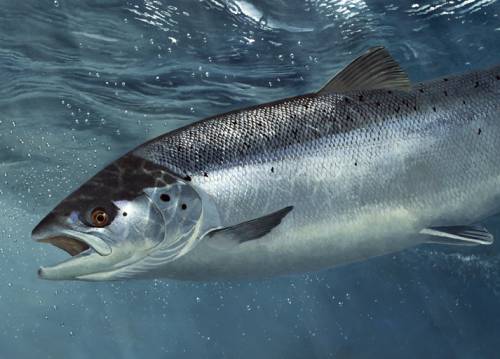Find background info and resources below, and call or write to your senators today!
 Call to Action: Call or write to your senators and ask them to support and cosponsor the Genetically Engineered Salmon Labeling Act (S.1528), which requires the labeling of GE salmon and independent reviews of the potential impact of GE salmon on human health and on wild salmon stocks.
Call to Action: Call or write to your senators and ask them to support and cosponsor the Genetically Engineered Salmon Labeling Act (S.1528), which requires the labeling of GE salmon and independent reviews of the potential impact of GE salmon on human health and on wild salmon stocks.
CALL: Dial 1-800-826-3688 and the operator will direct you to your first senator; then do it again.
OR
WRITE: Send as is or modify the letter on the PC(USA) Office of Public Witness site.
Background
The “AquAdvantage” salmon was developed by AquaBounty Technologies, Inc. It is an Atlantic salmon (Salmo salar) that has had its DNA spliced with a growth hormone gene from the unrelated Chinook salmon (Oncorhynchus tshawytscha) and antifreeze DNA from an Arctic eelpout (Zoarces americanus).

Click on the image to see a larger version. Both salmon pictured are 18-months old. The genetically engineered salmon grows about twice and fast and at this size is ready for market.
Normally, an Atlantic salmon’s growth hormone stimulates growth in the fish during certain months of the year, and will “turn off” growth during other months to devote its resources toward survival. However, due to the introduction of the eelpout’s anti-freeze DNA, the GE salmon produces growth hormone year-round, thus creating a fish that its developer claims can grow up to twice as fast as conventionally raised Atlantic salmon.
Despite insufficient food safety or environmental studies, the FDA announced its approval of the AquAdvantage Salmon for production in a facility in Indiana on April 27, 2018. Previously, in December 2012, the FDA released its draft Environmental Assessment of this genetically engineered salmon, and approved it in November 2015. The FDA approval was made despite the 1.8 million people who sent letters to them opposing approval of the so-called “frankenfish,” and the 75 percent of respondents to a New York Times poll who said they would not eat genetically engineered salmon.
The FDA said it would probably not require labeling of the fish; however, Alaska, a top wild salmon producer, requires labeling of genetically engineered salmon. Momentum is growing for GMO labeling in a number of states across the U.S. and at the federal level through this Senate bill from Alaska’s Senator Lisa Murkowski.
The FDA’s process is of concern for a number of reasons. A current lawsuit is challenging the FDA’s claim that it has authority to approve and regulate GE animals as “animal drugs” under the 1938 Federal Food, Drug, and Cosmetic Act. Those provisions were meant to ensure the safety of veterinary drugs administered to treat disease in livestock and were not intended to address entirely new GE animals that can pass along their altered genes to the next generation. The approval of the GE salmon opens the door to other genetically engineered fish and shellfish, as well as chickens, cows, sheep, goats, rabbits and pigs that are reportedly in development.
[See analysis from Friends of the Earth: Genetically Engineered Fish: An Unnecessary Risk to the Environment, Public Health and Fishing Communities (PDF)]
According to the Center for Food Safety, the GE salmon are nutritionally inferior with fewer healthy oils and acids, vitamins, and less protein than wild salmon.
[See report from the Center for Food Safety Genetically Engineered Salmon-The Next Generation of Industrial Aquaculture (PDF)]
Dr. Pete Knutson, owner of Loki Fish Company and Commissioner on the Puget Sound Salmon Commission, says “There were over 250 million wild salmon harvested in Alaska and Puget Sound this year. Why should we put this sustainable resource at risk for the benefit of a few multinational corporations who will, sooner or later, introduce GE salmon into their floating feed lots? Americans will be eating synthetic salmon, thinking they are receiving the nutritional benefits of wild salmon.”
“Salmon People” Film and Other Resources
The Community Alliance for Global Justice, a partner of the Presbyterian Hunger Program, has been working with Indigenous Peoples in the Pacific Northwest and helped develop a number of resources helpful to understanding the issues.
You can view this four-minute film called, “Salmon People – The Risks of Genetically Engineered Fish for the Pacific Northwest” See also the Study Guide and resources below.
Film Study Guide
- Community Alliance for Global Justice: Salmon People: A backgrounder to Northwest Tribal Opposition to GE Salmon (Online), CAGJ Salmon People Backgrounder(PDF)
- Muckleshoot Food Sovereignty Project Traditional Food Map and Principles(PDF)
- Resources on GE Salmon and Northwest Native Resistance (Online)
In addition to writing to your senators, you can also contact your favorite grocery stores, restaurants, and chefs and ask them to join the Campaign for GE-Free Seafood. Visit the website at www.gefreeseafood.org to learn more!
Here is a video about the AquAdvantage Salmon from the biotech industry: